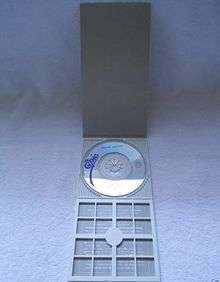Mini CD single
 Japanese 8cm CD single | |
| Media type | Compact disc |
|---|---|
| Capacity | 80 mm disc can hold up to 24 minutes of music, or 210 MB (210 × 220 bytes) of data. |
| Dimensions | 8 Centimetres (3.1Inch) |
| Usage | Audio storage |
The mini CD single (also 3-inch CD or CD3 in the US, in relation to the CD5, or the 5-inch CD single; commonly known as "snap-pack";[1] also known as "CD Single"[2]) is a music single released on a mini Compact Disc that measures 8 cm (3.1 in) in diameter, rather than the standard 12 cm (4.7 in). They are manufactured using the same methods as standard full-size CDs, and can be played in most standard audio CD players and CD-ROM disc drives.
The format was first released in the United Kingdom, Japan, United States, France, West Germany, and Hong Kong in 1988. Although the format was not widely available in the United Kingdom, several artists, such as Paula Abdul, Garbage, Catatonia, The Sisters of Mercy, Stereolab, Robert Palmer, Jentina and R.E.M. have released singles in the format. They also remain a popular, low cost way for independent musicians and groups to release music.
Japan
The snap-packs or (Japanese: tanzaku) as they are known in Japan, is a long strip of paper. The compact disc is 3 inches or 8 Japanese (8 cm) 3" CD singles were called 3" CD snap-packs, as they could be 'snapped' and folded into a small square rather than being the original 6×3-inch (15×8 cm) length type of packaging when sold. Most cost about ¥1000 (about UK£5.7 or US$9.2) at the time of release during the late 1980s. The last single was "I Was Born to Love You" by Queen in 2004. Many of the artists who released 3" CDs are from that era, including Madonna, Cher, Phil Collins, Michael Jackson, Queen, U2, Prince, Bros, Dead or Alive, Huey Lewis and the News, Bon Jovi, Kylie Minogue, Falco and George Michael.
United States
US versions were often packaged in cardboard slipcases, either 3" square or 6" by 3" gatefold. Others were released in 5" slimline single cases, which allowed an adapter to be included with the CD.
United Kingdom
UK 3" CDs were made mostly in a small square case/cover form only, some including a 5" CD adapter to use in normal compact disc players.
Most of the mini CD singles had at least two tracks, often consisting of a single edit, and an instrumental version.
Technology
From a technical standpoint, a 3-inch CD follows the Red Book standard for CD digital audio. The major difference is that the smaller physical size of the disc allows for fewer data sectors, meaning the disc can store less audio. The majority of audio CD players and CD-ROM drives have a smaller circular indentation in the CD tray for holding these discs. Some slot-loading drives, such as those found in some car CD players, are unable to manipulate the smaller discs or their adapters. Laptop drives generally only require the centre hole to hold the disc so the smaller diameter is irrelevant. In fact, software and drivers for some hardware are provided on the 3" discs.
In the United States and United Kingdom, the format barely lasted into the early 1990s, being replaced by simply putting less music on a regular full-size CD, at least among major labels. The full-size discs are a more standard manufacturing process and so may end up being cheaper to press. The CD single format continued until 2000 for Japanese releases. As of December 2007, the format is used in small CD runs by a wide range of independent artists and labels, many of which burn 3 inch CDR discs and make the covers themselves.
Technical specifications
- Data: 185-210MB (versus 650-703MB on a 12 cm CD)
- Audio: 21–24 minutes (versus 74–80 minutes on a 12 cm CD)[3][4]
The slim jewel boxes used for 3" CDs are nearly the same size as 3.5" floppy disks, making storage boxes for 3.5" floppies usable for 3" CDs as well.
References
- ↑ "Glossary of Music Terms". Alibris. Alibris, Inc. alibris.com. Retrieved 2015-03-30.
- ↑ http://sp.e-words.jp/p/r-cd.html
- ↑ 80 mm CD: Minus size - plus portability
- ↑ Red Book (CD standard)